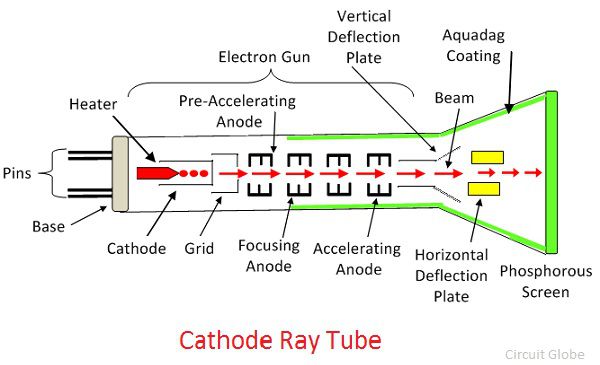The Cathode Ray Tube (CRT) is a foundational technology that played a vital role in early TV and computer monitors. It’s a vacuum tube with an electron gun emitting focused electrons onto a fluorescent screen. This creates images by manipulating electron beams. Originating in the late 1800s, CRT gained prominence in the mid-1900s. It transformed visual displays, converting electronic signals into visuals. Electron beams hitting a phosphorescent screen generate light points, creating images via controlled movements and intensities….
Basic Parts of Cathode Ray Tube
- Electron Gun Assembly – The electron gun assembly generates a beam of electrons.
- Anodes – The anodes accelerate the electrons.
- Deflection Plate Assembly – It consists of vertical and Horizontal Deflection panels. These panels produce a low-frequency electromagnetic field that is required to modify the regulation of electron beams.
- Fluorescent Display – The fluorescent screen is made of phosphorus. It converts electrical energy into light energy when the beam strikes it.
- Evacuated Glass Envelope – An evacuated glass envelope keeps the entire Cathode ray tube intact. It acts as a housing for all the parts of CRT.
Cathode Ray Tube Applications
- Frequently used as a television (TV) display
- Whenever rapidly cathode rays are abruptly halted, X-rays are created
- Fluorescent chemicals are used to cover the screen of a cathode ray oscilloscope and the display of a computer. So when cathode rays strike the screen, images appear on the screen
J. Thomson drew a few findings after using this technique. The rays seen as they transitioned from cation to anion were all negative. This then benefited future scientists in comprehending the present atomic structure. Additionally, they discovered that the quantity of voltage, the kind of gas, and its component ratios had no effect on or modified the natural, physical, and behavioural features of electrons. This established the electron as a self-contained subatomic particle with distinct features and behaviours that were eventually defined by a subsequent generation of scientists.
Revolutionizing Visual Displays
The concept of the Cathode Ray Tube (CRT) traces its roots to the late 1800s, yet it was in the mid-20th century that its potential in transforming visual display technology became evident. CRTs possessed the remarkable capability to translate electronic signals into visible images, marking a significant leap forward. As the electron beam struck the phosphorescent screen, it induced the phosphors to emit light, creating luminous points.
Through precise manipulation of the electron beam’s motion and modulation of intensity, CRTs ingeniously crafted images that appeared to seamlessly materialize on the screen. This breakthrough laid the foundation for the development of television sets. By synchronizing the electron beam’s movement with broadcast signals, CRTs brought to life moving images on screens. This pioneering achievement revolutionized entertainment, ushering television into households across the globe.
Limitations of CRT
While the Cathode Ray Tube (CRT) technology was revolutionary in its time, it also came with certain limitations that eventually contributed to its decline as newer display technologies emerged.
- Bulkiness and Size: CRTs were bulky due to the vacuum tube, electron gun, and screen, hampering portability and modern aesthetics.
- Limited Resolution: CRTs had lower resolution compared to newer displays. Larger screens posed challenges to maintaining image quality.
- Energy Consumption: CRTs consumed more power due to electron acceleration, contributing to higher bills and environmental concerns.
- Screen Flicker: Rapid electron scanning caused visible flickering, straining eyes during extended use.
- Heating: CRTs produced heat, necessitating extra cooling mechanisms, increasing power usage, and possibly affecting the device’s lifespan.
- Geometric Distortions: CRTs were prone to geometry issues like screen curvature and colour misalignment, demanding frequent adjustments for optimal display quality.
The Decline and Legacy
- Although CRTs had a significant impact, their limitations led to their decline. They were bulky, consumed more power, and had resolution constraints compared to newer technologies. With digital advancements, compact and energy-efficient alternatives like LCDs and LEDs emerged.
- While CRTs are no longer mainstream, their legacy lives on. They represent a pivotal shift from analogue to digital visual display. Concepts like electron beams and controlled movements paved the way for subsequent display innovations….
Conclusion
The discovery of electrons led by sir J.J Thomson via cathode ray tube experiment is one of the most widely regarded experiments in physics. This discovery opened wide gates in the field of science, which significantly helped other scientists to achieve their experiments and discoveries with ease.
FAQs About CRT
A Cathode Ray Tube (CRT) is a technology used in early television sets, computer monitors, and other displays.
CRTs faced limitations such as bulkiness, higher power consumption, and lower resolution compared to newer technologies.
CRTs were bulky and heavy, consuming more power. They had limitations in achieving high resolutions, which impacted image clarity.
CRTs used an electron gun to emit a focused beam of electrons. This beam was directed onto a phosphorescent screen
Related posts:
- AMC Full Form: Benefits, Components, Needs, Advantage
- ORS Full Form: Dehydration, Myths, Flavors, Varieties & Facts
- PCC Full Form: Importance, Types, Application Process
- PAN Full Form: Legal Provisions, Regulations,
- BRB Full Form: Productive, Routine, Distractions
- MCD Full From: Introduction, Responsibility, Challenges
- CT Scan Full Form: Scans, price, Advantages
- USA Full Form: History, Economics,Technology, culture





















